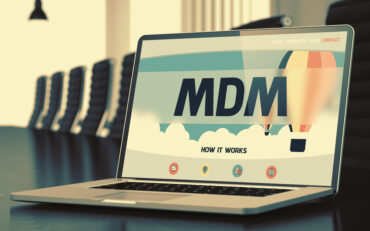
AWS may feel like the safe choice and one that won’t end in your demise. Just remember that it could be your company that ends in ruin if it’s overrun by the costs before it can achieve the revenue promise of AI. Smart investors know the path to success: Hedge your bets, diversify, and win.
Did you know there was once a time when physical tickets to concerts and sporting events arrived in the mail? It actually wasn’t that long ago. What was once the norm has become a relic of the past. The shift to mobile tickets was gradual at first – almost reluctant – as trust was low with the new technology. But as mobile technology evolved and security improved, adoption picked up steam, and a new paradigm emerged, and we never looked back.
Cloud computing has experienced a similar coming-of-age. It’s incredible to think that just 10 years ago, there was a raging battle unfolding to determine the prevailing data center model. On-premises had ruled the world for decades, but two flavors of cloud computing – private and public – arrived on the scene with all the flashy headlines and benefits for IT leaders.
At first, it looked like the public cloud model might not survive. Lack of confidence in the cloud concept – and even less trust in security and multitenancy – made the idea of moving a company’s IP to another company whose servers and storage would be hosting the workloads and data of thousands of companies unbelievable. But over time, the likes of AWS, Google, and Microsoft won a critical mass of hearts and wallets based on vital attributes like convenience, availability, reliability, security, and, yes, affordability. A new industry was born, supported by a new category of service provider – the hyperscaler.
See also: Gartner Forecasts Robust Growth in Worldwide Public Cloud Spending
AWS following Amazon’s playbook
One of the core strategies Amazon employed to become a retail behemoth was offering low prices to gain market share at the beginning. Once it secured its leadership position, power, and market influence, it gradually started raising prices across much of its site(s). The hallmark of Amazon’s strategy has always been to gain adoption, shift buyer behavior, and then continue to drive more business. This became the blueprint for many other parts of Amazon’s business, including Amazon Web Services. In fact, according to a 2023 Liftr report, AWS raised prices for four consecutive years. Even as computing power costs have decreased, they have raised their prices.
AI race can make or break growing companies
For many companies, reluctantly accepting annual price increases for cloud compute resources seemed manageable. But then AI came along and changed the landscape. Suddenly, the race was on to position AI at the core of as many business processes as possible – to reach AI maturity as fast as possible. The stakes are high, and the hyperscalers have been very willing to be on the receiving end of the demand. But at what cost to the end user?
The traditional hyperscalers are hampering the companies of tomorrow. Flexibility has been reserved for only the largest cloud customers with the deepest pockets. Everyone else has been forced into accepting rigid and restrictive contract terms and paying for additional services they often don’t need or want. And once locked into these contracts, finding alternative options can be difficult, time-consuming, and even costly. Once again, the entire data center paradigm is overdue for massive transformation.
The composable cloud era
It’s time for all cloud providers to join the composable cloud movement. Composability is a commitment to making infrastructure, tools, and services interoperable for the customer’s benefit. Providers that commit to composability provide their customers with choice – choice in tech stack components, choice in supporting tools and services, choice in vendors offering these components, tools, and services, and choice in what environment to use for each workload.
Composability offers greater flexibility across all layers of the cloud stack, from infrastructure (IaaS) to platform (PaaS) to application services (SaaS). This flexibility and choice shift the balance of power back in favor of the customer, giving them greater control over the prices they pay for cloud services. Customers can vote with their wallets, choosing to work with the cloud vendors that offer the optimal combination of services and prices to address their unique profile of needs.
See also: From Strategy to Adoption: Integrating AI in Cloud Migration and Platform Modernization
Protect your data assets with diversification
One of the choices companies can and should make is to take a multi-cloud approach. By using multiple vendors, you can align your workloads with the vendors whose capabilities best suit your specific business needs while minimizing vendor lock-in. This approach also provides substantial protection for your data and cloud operations.
In May 2024, Google Cloud accidentally deleted the account of an Australian pension fund, which involved $135 billion worth of funds and 647,000 members. Thankfully, this customer employed a multi-cloud strategy and had back-ups with another provider. This cautionary tale demonstrates that if you don’t have a multi-cloud strategy, you are putting your data, your company, your job, and potentially your clients at tremendous risk.
Multi-cloud strategy is critical not only from a data security perspective; it’s also the way companies can literally save hundreds of thousands of dollars by leveraging the right provider for the right workload at the right price. If you’re looking to scale your AI Operations (AIOps) globally, you need the right partner(s) that can meet your current and future needs and adapt along the way.
Not all hyperscalers are created equal – differences in services and cost structures can significantly impact your operations. Choosing the right partner is crucial to scaling efficiently and cost-effectively. It’s about finding the optimal load management for your workload at any given time. It’s about pressing them to tailor their cloud environments to your needs, ensuring you remain agile and cost-efficient while meeting the demands of an ever-changing technological landscape. It’s about paying only for what you need when you need it.
It’s also a matter of trust
Trust in AI is also crucial for companies and their end users. As enterprises expand their AIOps globally, they need a provider capable of delivering a robust global AI architecture and infrastructure that fosters trust in AI within competitive marketplaces. A company’s cloud partners must manage load, maintain security and privacy, and optimize costs. They must also adhere to core AI principles: mature AI, responsible AI, composable AI, and affordable AI. By ensuring these foundational elements, enterprises can build and maintain the trust of their customers, ultimately driving success in diverse markets.
So as you consider your cloud strategy for your organization, remember that unlike the concert industry, you have a choice other than Ticketmaster/Live Nation. AWS may feel like the safe choice and one that won’t end in your demise. Just remember that it could be your company that ends in ruin if it’s overrun by the costs before it can achieve the revenue promise of AI. Smart investors know the path to success: Hedge your bets, diversify, and win.





























